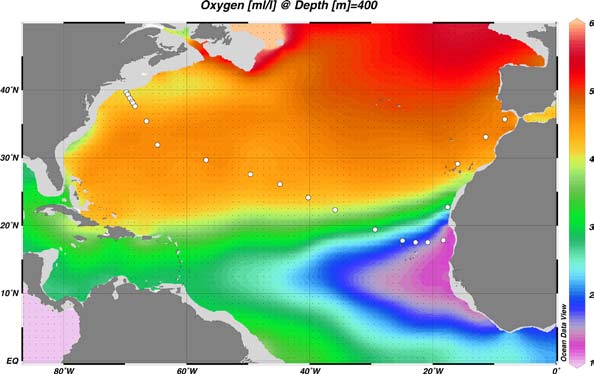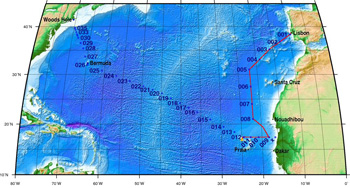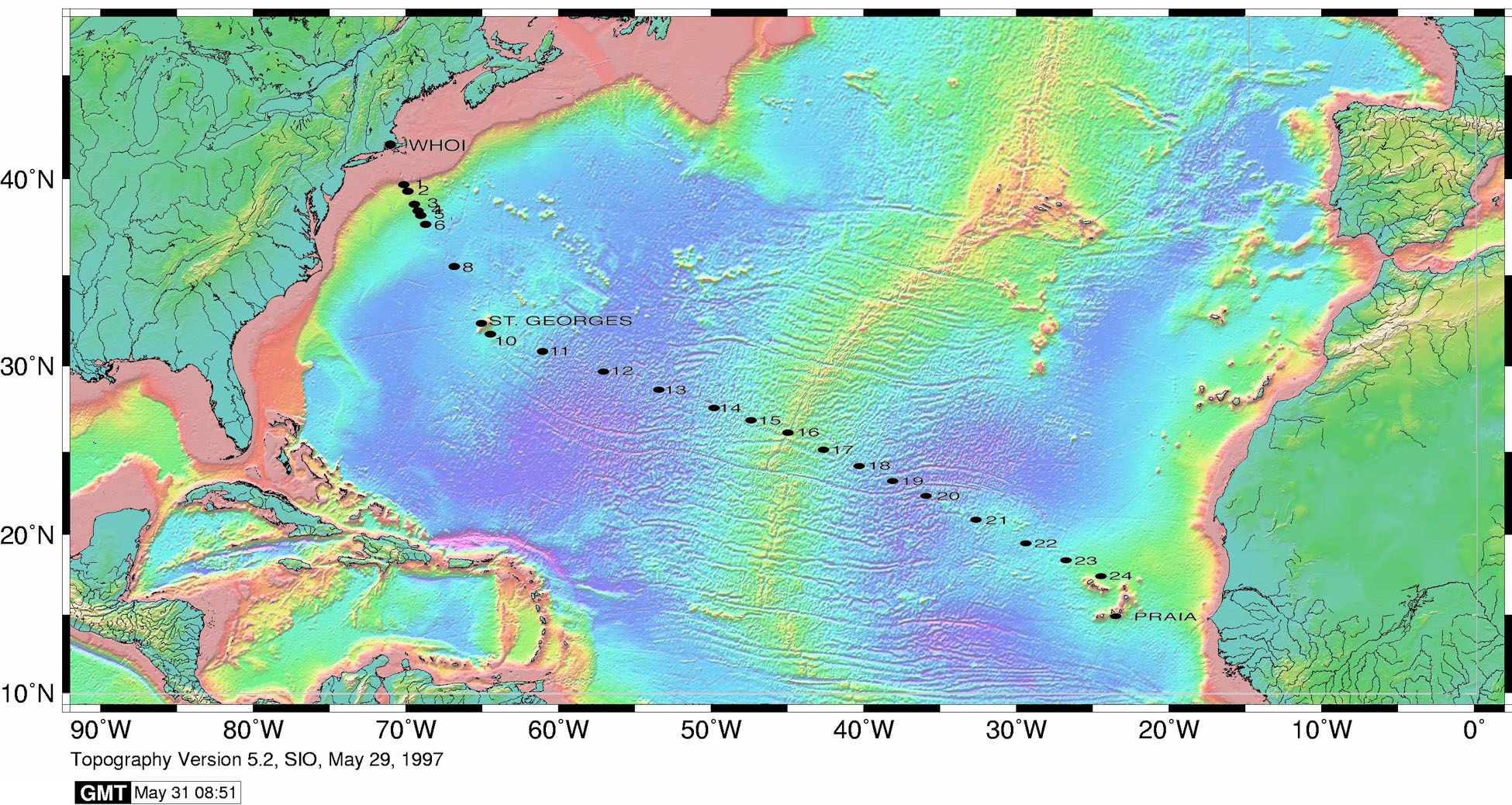Surface arsenic, antimony speciation, and alkaline phosphatase activity along with US GEOTRACES North Atlantic Transect from the R/V Knorr KN199-04, KN199-05 cruises in the subtropical N. Atlantic during 2010 (U.S. GEOTRACES NAT project)
Project
Program
| Contributors | Affiliation | Role |
|---|---|---|
| Cutter, Gregory A. | Old Dominion University (ODU) | Principal Investigator |
| Wurl, Oliver | Leibniz Institute for Baltic Sea Research Warnemunde Germany | Contact, Contact |
| Gegg, Stephen R. | Woods Hole Oceanographic Institution (WHOI BCO-DMO) | BCO-DMO Data Manager |
| McKee, Theresa | Woods Hole Oceanographic Institution (WHOI BCO-DMO) | BCO-DMO Data Manager |
Abstract
Data for the concentrations of the dissolved (<0.4 µm) arsenic species: total inorganic As (III+V), arsenite (AsIII), arsenate (AsV), monomethyl As, and dimethyl As; and the activity of the enzyme alkaline phosphatase (unfiltered) on the surface transect.
Modification history: Data were updated 3 January 2013
Please note that some US GEOTRACES data may not be final, pending intercalibration results and further analysis. If you are interested in following changes to US GEOTRACES NAT data, there is an RSS feed available via the BCO-DMO US GEOTRACES project page (http://www.bco-dmo.org/project/2066; scroll down and expand the "Datasets" section).
Filtered (0.4 µm) water samples from the Geotraces surface tow-fish taken at discrete times into 500 mL Teflon FEP bottles, refrigerated, and analyzed within 24 hours of collection. Arsenic and antimony speciation determined using selective hydride generation, liquid nitrogen-cooled trapping, and then revolatilization and determination with gas chromatography/photoionization detection (Cutter et al., 1991; Cutter and Cutter, 2006). Calibration performed daily via the standard additions method, with a minimum of 4 additions of AsIII, AsV, MMAs, or DMAs depending on the analyses. The slope from the linear fit to these data was then applied to all samples for that day. Detection limits were 25 pmol/L for As(III) and As(III+V), and 50 pmol/L for MMAs and DMAs. Precision was better than 8% (relative standard deviation) for all As species. Alkaline phosphatase enzyme activity was measured using the fluorescence method of Ammerman (1993).
Samples analyzed in duplicate or triplicate and means computed.
BCO-DMO Processing Notes
- Generated from original .xls file "GEOTRACES Knorr 199-4 and -5 As Sb AP.xls" contributed by Greg Cutter
- cruise id converted to official UNOLS cruise id
- Year,Month,Day combined into Date and reformatted as YYYYMMDD
- Hour,Minute combined into Time and reformatted as HHMM
- "nd" (no data) value inserted in blank cells
- Parameter names modified to conform to BCO-DMO convention
| File |
|---|
As_AP_surface_GT10.csv (Comma Separated Values (.csv), 13.71 KB) MD5:953b2a3218528c6103c0450c6f6905df Primary data file for dataset ID 3520 |
| Parameter | Description | Units |
| cruise_id | cruise id | text |
| transect_station | station identifier within transect | text |
| date | Date in the format YYYYMMDD | unitless |
| time | Time | HHMM |
| lat | Latitude (South is negative) | decimal degrees |
| lon | Longitude (West is negative) | decimal degrees |
| AsIII | Arsenite (HAsO32-) | nmol/L |
| TAs | Total inorganic arsenic (AsIII+V) | nmol/L |
| MMAs | Monomethyl arsenic | nmol/L |
| DMAs | Dimethyl arsenic | nmol/L |
| AP_Turnover_Time | Alkaline phosphatase turnover time | hours |
| AP_Turnover_Rate | Alkaline phosphatase turnover rate | h-1 |
| As | As(V) | nanomoles/liter |
| Dataset-specific Instrument Name | Gas Chromatograph |
| Generic Instrument Name | Gas Chromatograph |
| Dataset-specific Description | (tbd) |
| Generic Instrument Description | Instrument separating gases, volatile substances, or substances dissolved in a volatile solvent by transporting an inert gas through a column packed with a sorbent to a detector for assay. (from SeaDataNet, BODC) |
| Dataset-specific Instrument Name | UCSC designed "GeoFish" towed sampling system |
| Generic Instrument Name | GeoFish Towed near-Surface Sampler |
| Dataset-specific Description | Surface seawater samples were collected from ~2-5 meters depth outside of ship's influence using the UCSC designed "GeoFish" towed sampling system.
All surface samples were filtered and then homogenized in one or two of the 500 L SAFe tanks
GeoFish/SAFe tank system consists of PFA TeflonTM tubing, an all PFA TeflonTM diaphragm pump, sequential filtration through 0.45 µm then 0.2 µm pore size polycarbonate, track etched (PCTE) pleated filter cartridges and two 500 L fluorinated low density polyethylene tanks connected with all TeflonTM tubing, valves and fittings. All filtrations, acidifications and bottling of the SAFe and GEOTRACES samples were performed inside of Class-100 clean benches in a portable clean van. |
| Generic Instrument Description | The GeoFish towed sampler is a custom designed near surface ( |
| Dataset-specific Instrument Name | towed undulating vehicle |
| Generic Instrument Name | towed undulating vehicle |
| Generic Instrument Description | A towed undulating vehicle is a generic class of instruments. See the data set specific information for a detailed description. These are often prototype instrument packages designed to make very specific measurements. |
KN199-04
| Website | |
| Platform | R/V Knorr |
| Report | |
| Start Date | 2010-10-15 |
| End Date | 2010-11-04 |
| Description | This cruise constitutes the first survey section as part of the U.S. participation in an international program named GEOTRACES.
Funding: NSF OCE award 0926423
Science Objectives: To obtain state of the art trace metal and isotope measurements on a suite of samples taken on a mid-latitude zonal transect of the North Atlantic. In particular, sampling targeted the oxygen minimum zone extending off the west African coast near Mauritania, the TAG hydrothermal field, and the western boundary current system along Line W. For additional information, please refer to the GEOTRACES program Web site (https://www.geotraces.org/) for overall program objectives and a summary of properties measured.
Science Activities include seawater sampling via GoFLO and Niskin carousels, in situ pumping (and filtration), CTDO2 and transmissometer sensors, underway pumped sampling of surface waters, and collection of aerosols and rain. Hydrography, CTD and nutrient measurements were supported by the Ocean Data Facility (J. Swift) at Scripps Institution of Oceanography and funded through NSF Facilities. They provided an additional CTD rosette system along with nephelometer and LADCP. A trace metal clean Go-Flo Rosette and winch were provided by the group at Old Dominion University (G. Cutter) along with a towed underway pumping system.
Additional cruise information is available from the Rolling Deck to Repository (R2R): https://www.rvdata.us/search/cruise/KN199-04
Other Relevant Links:
List of cruise participants: [ PDF ]
Cruise track: JPEG image (from Woods Hole Oceanographic Institution, vessel operator)
ADCP data are available from the Currents ADCP group at the University of Hawaii: KN199-04 ADCP |
KN199-05
| Website | |
| Platform | R/V Knorr |
| Start Date | 2010-11-08 |
| End Date | 2010-11-26 |
| Description | KN199-05 is the completion of the US GEOTRACES Zonal North Atlantic Survey Section cruise originally planned for late Fall 2010 from Lisboa, Portugal to Woods Hole, MA, USA.
Due to engine failure, the science activities scheduled for the KN199-04 cruise were canceled on 2 November 2010. On 4 November the R/V Knorr put in at Porto Grande, Cape Verde (ending KN199 leg 4) and was scheduled to depart November 8, under the direction of Acting Chief Scientist Oliver Wurl of Old Dominion University. The objective of KN199 leg 5 (KN199-05) was to carry the vessel in transit to Charleston, SC while conducting abbreviated science activities originally planned for KN199-04.
Funding: NSF OCE award 0926423
Science Objectives: To obtain state of the art trace metal and isotope measurements on a suite of samples taken on a mid-latitude zonal transect of the North Atlantic. In particular, sampling targeted the oxygen minimum zone extending off the west African coast near Mauritania, the TAG hydrothermal field, and the western boundary current system along Line W. For additional information, please refer to the GEOTRACES program Web site (https://www.geotraces.org/) for overall program objectives and a summary of properties measured.
Science Activities include seawater sampling via GoFLO and Niskin carousels, in situ pumping (and filtration), CTDO2 and transmissometer sensors, underway pumped sampling of surface waters, and collection of aerosols and rain. Hydrography, CTD and nutrient measurements were supported by the Ocean Data Facility (J. Swift) at Scripps Institution of Oceanography and funded through NSF Facilities. They provided an additional CTD rosette system along with nephelometer and LADCP. A trace metal clean Go-Flo Rosette and winch were provided by the group at Old Dominion University (G. Cutter) along with a towed underway pumping system.
Additional cruise information is available from the Rolling Deck to Repository (R2R): https://www.rvdata.us/search/cruise/KN199-05
Other Relevant Links:
List of cruise participants: [ PDF ]
ADCP data are available from the Currents ADCP group at the University of Hawaii: KN199-05 ADCP |
U.S. GEOTRACES North Atlantic Transect (GA03) (U.S. GEOTRACES NAT)
Much of this text appeared in an article published in OCB News, October 2008, by the OCB Project Office.
The first U.S. GEOTRACES Atlantic Section will be specifically centered around a sampling cruise to be carried out in the North Atlantic in 2010. Ed Boyle (MIT) and Bill Jenkins (WHOI) organized a three-day planning workshop that was held September 22-24, 2008 at the Woods Hole Oceanographic Institution. The main goal of the workshop, sponsored by the National Science Foundation and the U.S. GEOTRACES Scientific Steering Committee, was to design the implementation plan for the first U.S. GEOTRACES Atlantic Section. The primary cruise design motivation was to improve knowledge of the sources, sinks and internal cycling of Trace Elements and their Isotopes (TEIs) by studying their distributions along a section in the North Atlantic (Figure 1). The North Atlantic has the full suite of processes that affect TEIs, including strong meridional advection, boundary scavenging and source effects, aeolian deposition, and the salty Mediterranean Outflow. The North Atlantic is particularly important as it lies at the "origin" of the global Meridional Overturning Circulation.
It is well understood that many trace metals play important roles in biogeochemical processes and the carbon cycle, yet very little is known about their large-scale distributions and the regional scale processes that affect them. Recent advances in sampling and analytical techniques, along with advances in our understanding of their roles in enzymatic and catalytic processes in the open ocean provide a natural opportunity to make substantial advances in our understanding of these important elements. Moreover, we are motivated by the prospect of global change and the need to understand the present and future workings of the ocean's biogeochemistry. The GEOTRACES strategy is to measure a broad suite of TEIs to constrain the critical biogeochemical processes that influence their distributions. In addition to these "exotic" substances, more traditional properties, including macronutrients (at micromolar and nanomolar levels), CTD, bio-optical parameters, and carbon system characteristics will be measured. The cruise starts at Line W, a repeat hydrographic section southeast of Cape Cod, extends to Bermuda and subsequently through the North Atlantic oligotrophic subtropical gyre, then transects into the African coast in the northern limb of the coastal upwelling region. From there, the cruise goes northward into the Mediterranean outflow. The station locations shown on the map are for the "fulldepth TEI" stations, and constitute approximately half of the stations to be ultimately occupied.
Figure 1. The proposed 2010 Atlantic GEOTRACES cruise track plotted on dissolved oxygen at 400 m depth. Data from the World Ocean Atlas (Levitus et al., 2005) were plotted using Ocean Data View (courtesy Reiner Schlitzer). [click on the image to view a larger version]

Hydrography, CTD and nutrient measurements will be supported by the Ocean Data Facility (J. Swift) at Scripps Institution of Oceanography and funded through NSF Facilities. They will be providing an additional CTD rosette system along with nephelometer and LADCP. A trace metal clean Go-Flo Rosette and winch will be provided by the group at Old Dominion University (G. Cutter) along with a towed underway pumping system.
The North Atlantic Transect cruise began in 2010 with KN199 leg 4 (station sampling) and leg 5 (underway sampling only) (Figure 2).
Figure 2. The red line shows the cruise track for the first leg of the US Geotraces North Atlantic Transect on the R/V Knorr in October 2010. The rest of the stations (beginning with 13) will be completed in October-December 2011 on the R/V Knorr (courtesy of Bill Jenkins, Chief Scientist, GNAT first leg). [click on the image to view a larger version]

The section completion effort resumed again in November 2011 with KN204-01A,B (Figure 3).
KN204-01A,B Cruise Report (PDF)
Figure 3. Station locations occupied on the US Geotraces North Atlantic Transect on the R/V Knorr in November 2011. [click on the image to view a larger version]

Data from the North Atlantic Transect cruises are available under the Datasets heading below, and consensus values for the SAFe and North Atlantic GEOTRACES Reference Seawater Samples are available from the GEOTRACES Program Office: Standards and Reference Materials
ADCP data are available from the Currents ADCP group at the University of Hawaii at the links below:
KN199-04 (leg 1 of 2010 cruise; Lisbon to Cape Verde)
KN199-05 (leg 2 of 2010 cruise; Cape Verde to Charleston, NC)
KN204-01A (part 1 of 2011 cruise; Woods Hole, MA to Bermuda)
KN204-01B (part 2 of 2011 cruise; Bermuda to Cape Verde)
U.S. GEOTRACES (U.S. GEOTRACES)
GEOTRACES is a SCOR sponsored program; and funding for program infrastructure development is provided by the U.S. National Science Foundation.
GEOTRACES gained momentum following a special symposium, S02: Biogeochemical cycling of trace elements and isotopes in the ocean and applications to constrain contemporary marine processes (GEOSECS II), at a 2003 Goldschmidt meeting convened in Japan. The GEOSECS II acronym referred to the Geochemical Ocean Section Studies To determine full water column distributions of selected trace elements and isotopes, including their concentration, chemical speciation, and physical form, along a sufficient number of sections in each ocean basin to establish the principal relationships between these distributions and with more traditional hydrographic parameters;
* To evaluate the sources, sinks, and internal cycling of these species and thereby characterize more completely the physical, chemical and biological processes regulating their distributions, and the sensitivity of these processes to global change; and
* To understand the processes that control the concentrations of geochemical species used for proxies of the past environment, both in the water column and in the substrates that reflect the water column.
GEOTRACES will be global in scope, consisting of ocean sections complemented by regional process studies. Sections and process studies will combine fieldwork, laboratory experiments and modelling. Beyond realizing the scientific objectives identified above, a natural outcome of this work will be to build a community of marine scientists who understand the processes regulating trace element cycles sufficiently well to exploit this knowledge reliably in future interdisciplinary studies.
Expand "Projects" below for information about and data resulting from individual US GEOTRACES research projects.
| Funding Source | Award |
|---|---|
| NSF Division of Ocean Sciences (NSF OCE) | |
| NSF Division of Ocean Sciences (NSF OCE) |
[ table of contents | back to top ]